Mastering Adventure Travel on Sahara Desert Safaris
Embarking on a Sahara Desert safari is like stepping into a vast, golden sea where the dunes undulate like waves frozen in time. As you prepare to navigate this awe-inspiring landscape, there are essential tips and tricks that will elevate your adventure from merely surviving to truly mastering the art of desert travel.
From choosing the right safari tour to capturing the magic through photography, there are countless facets to consider.
So, as you stand on the edge of this boundless expanse, ready to immerse yourself in the challenges and wonders of the Sahara, let's explore the keys to unlocking a truly unforgettable experience.
Choosing the Right Safari Tour
When choosing the right Sahara Desert safari tour, consider your preferences, budget, and level of adventure. Start by researching different tour operators to find one that aligns with your travel style. Look for operators that offer a variety of itinerary options to cater to different preferences. Whether you're interested in camel treks, dune bashing, or camping under the stars, finding a tour operator with diverse itinerary options is key to ensuring a fulfilling experience.
As you explore the available itinerary options, consider the level of adventure each tour offers. Some tours may focus more on cultural experiences and sightseeing, while others may emphasize adrenaline-pumping activities. Assess your comfort level with activities such as sandboarding or quad biking, and choose an itinerary that matches your desired level of adventure.
Additionally, keep your budget in mind when selecting a Sahara Desert safari tour. While some tours may include luxury accommodations and gourmet meals, others may offer a more budget-friendly experience with basic camping facilities. Determine what amenities and inclusions are important to you, and find a tour that fits within your budget constraints.
Ultimately, the key to choosing the right Sahara Desert safari tour is to align the available itinerary options with your preferences, budget, and desired level of adventure. By selecting a tour operator that offers diverse itineraries and caters to different travel styles, you can ensure an unforgettable experience exploring the wonders of the Sahara Desert.
Essential Gear and Packing Tips
Packing for your Sahara Desert safari requires essential gear to ensure your comfort and safety in the desert environment. Here are some essential items to pack for your adventure:
- Camping Essentials: When venturing into the Sahara, it's crucial to have the right camping gear. A sturdy tent, sleeping bag, and a reliable camping stove are essential. Additionally, pack lightweight, non-perishable food items and plenty of water to stay nourished and hydrated during your expedition.
- Survival Skills: Equip yourself with a basic first aid kit, a multi-tool, and a map or GPS device. It's also wise to carry a reliable compass and have a good understanding of how to use it. Knowing basic survival skills such as finding water sources and building a shelter can be invaluable in emergency situations.
- Desert Fashion: Dressing appropriately for the desert isn't just about fashion; it's about protection from the intense sun and extreme temperatures. Lightweight, long-sleeved clothing and a wide-brimmed hat will shield you from the sun. Don't forget to pack a pair of durable, comfortable hiking boots to protect your feet from rough terrain.
- Sun Protection: Along with suitable clothing, sunscreen with a high SPF, UV-protective sunglasses, and a scarf or shemagh to shield your face from blowing sand are essential. Protecting yourself from the sun's harsh rays is vital for a safe and enjoyable desert experience.
Safety Precautions in the Desert

Before embarking on your Sahara Desert safari, ensuring your safety in the desert environment is paramount, requiring a thorough understanding of essential safety precautions to follow.
Survival skills are crucial for your safety in the Sahara Desert. Firstly, always carry more water than you think you'll need. Dehydration in the desert can be life-threatening, so it's essential to stay well-hydrated.
Additionally, familiarize yourself with basic survival skills such as finding shelter, signaling for help, and navigating without landmarks. Understanding how to protect yourself from the sun and extreme temperatures is also vital.
Emergency communication is another critical aspect of desert safety. Make sure to have a reliable means of communication, such as a satellite phone or emergency beacon, in case of unforeseen circumstances. It's also wise to inform someone of your travel plans and expected return time. In the event of an emergency, this information can be invaluable for search and rescue teams.
Lastly, always travel with a companion if possible. Having a partner significantly increases your chances of survival in case of an emergency.
Exploring the Diverse Desert Landscapes
To fully appreciate the Sahara Desert, you must immerse yourself in its diverse and captivating landscapes. The desert isn't just a vast expanse of sand; it's a varied terrain that offers unique experiences and challenges. Here's what you need to know to make the most of exploring the diverse desert landscapes:
- Desert Wildlife and Conservation Efforts: The Sahara is home to a surprising variety of wildlife, including the iconic camels, desert foxes, and fennec foxes. However, due to environmental changes and human activities, many of these species are at risk. By supporting and learning about conservation efforts, you can contribute to the preservation of these unique ecosystems.
- Extreme Weather and Survival Techniques: The desert presents extreme weather conditions, from scorching heat during the day to freezing temperatures at night. Understanding survival techniques such as finding water sources, navigating the terrain, and building shelter is crucial for your safety and enjoyment.
- Adaptation of Flora and Fauna: The flora and fauna of the Sahara have adapted to the harsh desert conditions in remarkable ways. From drought-resistant plants to nocturnal animals, each aspect of the desert's ecosystem has evolved to thrive in this challenging environment.
- Breathtaking Landscapes: From the towering sand dunes of the Erg Chebbi to the rugged mountains of the Hoggar, the Sahara offers an array of breathtaking landscapes that are a testament to the power and beauty of nature.
Exploring the diverse desert landscapes of the Sahara is a truly enriching experience that will leave you with a deep appreciation for the resilience of life in one of the world's most extreme environments.
Interacting With Local Bedouin Communities

As you explore the diverse desert landscapes of the Sahara, engaging with local Bedouin communities offers a unique opportunity to gain insight into the traditional ways of life and cultural richness that thrive amidst this challenging environment. Cultural immersion in the Sahara desert allows you to experience firsthand the customs, traditions, and daily rituals of the Bedouin people. By participating in their daily activities such as cooking traditional meals, learning about their nomadic lifestyle, and engaging in their music and dance, you can gain a deeper understanding of their heritage and values.
Community engagement with the local Bedouin population provides a chance to forge meaningful connections and exchange stories that transcend language barriers. This interaction fosters mutual respect, understanding, and appreciation for the resilience and resourcefulness of the Bedouin communities. Engaging in conversations with the Bedouins about their history, beliefs, and survival strategies in the desert will enrich your adventure travel experience and leave a lasting impact.
Furthermore, interacting with local Bedouin communities presents an opportunity to support their livelihoods through the purchase of handmade crafts or by participating in sustainable tourism initiatives that benefit the community directly. By engaging with the Bedouins in a respectful and responsible manner, you contribute to the preservation of their cultural heritage and the promotion of sustainable tourism practices in the Sahara desert.
Navigating the Challenges of the Sahara
Navigating the challenges of the Sahara requires careful planning and preparation to ensure a safe and rewarding adventure. The desert presents unique obstacles that must be tackled with caution and foresight. Here are some key factors to consider when navigating the challenges of the Sahara:
- Desert navigation: The vast and seemingly endless expanse of the Sahara can be disorienting, making navigation a significant challenge. It's crucial to have expert guides who are familiar with the terrain and can lead you safely through the desert. Additionally, GPS devices and maps should be utilized as backup tools to ensure you stay on course.
- Extreme weather: The Sahara is known for its extreme temperatures, ranging from scorching heat during the day to freezing cold at night. Adequate preparation for these temperature fluctuations is essential. Proper clothing, including lightweight, breathable fabrics for the day and insulated layers for the chilly nights, is crucial for your comfort and safety.
- Sandstorms: The Sahara is prone to sudden and violent sandstorms, which can significantly impact visibility and navigation. It's imperative to be aware of weather forecasts and take appropriate shelter during these storms to avoid getting lost or disoriented.
- Water scarcity: The scarcity of water in the desert is a critical challenge. It's essential to carry an ample supply of water and to carefully plan your itinerary to ensure access to water sources along your route.
Capturing the Magic Through Photography

Capturing the magic of the Sahara through photography allows you to preserve the awe-inspiring beauty of this desert landscape in vivid detail. When photographing the Sahara, it's essential to employ the right photography techniques to truly capture the essence of this magnificent desert. The key to successful desert photography lies in understanding the unique lighting conditions of the Sahara. The desert sun can create striking contrasts and deep shadows, making it crucial to experiment with exposure settings to achieve the perfect balance.
One of the most captivating subjects for Sahara photography is its diverse wildlife. From the majestic camels to the elusive Fennec foxes, the desert is home to a wide array of fascinating creatures. To capture these animals in their natural habitat, it's important to practice patience and stealth. Utilize long lenses to maintain a safe distance while still capturing intricate details. Additionally, consider the rule of thirds to compose visually appealing shots and convey the vastness of the desert landscape.
Another crucial aspect of desert photography is to showcase the unique textures and patterns that define the Sahara. From the rippling sand dunes to the rugged rock formations, the desert offers a wealth of visually captivating elements. Experiment with different angles and perspectives to highlight the intricate details and create compelling compositions.
Sustainable Practices for Desert Travel
To ensure the preservation of the awe-inspiring beauty and wildlife of the Sahara, it's essential to embrace sustainable practices for desert travel. By adopting eco-friendly camping and prioritizing wildlife conservation, you can minimize your impact on this delicate ecosystem and contribute to its long-term protection. Here are some key sustainable practices to consider:
- Eco-friendly Camping: Choose campsites that have minimal impact on the environment, use biodegradable products, and follow Leave No Trace principles. Opt for reusable or recyclable camping gear and minimize waste by packing out all your trash.
- Wildlife Conservation: Respect the natural habitat of the Sahara's wildlife by observing from a distance and not disturbing or feeding the animals. Stay on designated paths to avoid trampling vegetation and disrupting animal habitats. Support local conservation efforts and learn about the native species to appreciate and protect them better.
- Energy and Water Conservation: Conserve water by using it sparingly for cooking, cleaning, and personal hygiene. Minimize energy consumption by using solar-powered or rechargeable devices and reducing unnecessary lighting and electronic usage.
- Responsible Travel: Choose tour operators and guides who prioritize sustainable practices and support local communities. Respect the cultural traditions of the indigenous people and purchase locally made souvenirs to contribute to the region's economy.
Frequently Asked Questions
What Are the Visa Requirements for Visiting the Sahara Desert?
For visiting the Sahara Desert, you need to check the visa requirements for your specific country. Make sure to also get travel insurance to cover any unexpected situations during your adventure.
Are There Any Specific Health Precautions or Vaccinations Needed for Traveling to the Sahara Desert?
Before traveling to the Sahara Desert, it's essential to consider health precautions and vaccination requirements. Due to the extreme conditions, it's recommended to have vaccinations for diseases like Hepatitis A, Typhoid, and Tetanus.
How Do I Navigate Language Barriers When Interacting With Locals in the Sahara Desert?
When navigating communication in the Sahara Desert, use simple phrases and gestures to overcome language barriers. Learn common desert greetings and gestures beforehand to show respect and build rapport with the locals.
What Are the Options for Accommodations During a Sahara Desert Safari?
When planning your Sahara Desert safari, consider various accommodation options. Luxury camps offer premium amenities, while budget options provide a more affordable stay. Tented camps and desert lodges are also popular choices, each offering a unique desert experience.
Are There Any Specific Cultural Customs or Etiquette I Should Be Aware of When Visiting the Sahara Desert?
When visiting the Sahara Desert, be mindful of cultural customs. Respect traditional attire, avoid pointing with fingers, and accept offerings with your right hand. Embrace the local cuisine and follow dining etiquette, using your right hand for eating.
Conclusion
Now that you've mastered the art of adventure travel on Sahara desert safaris, you're ready to embark on an unforgettable journey. With the right safari tour, essential gear, and safety precautions in place, you can confidently explore the diverse landscapes and interact with local Bedouin communities.
Remember to navigate the challenges of the Sahara with caution and capture the magic through photography. And always practice sustainable travel to protect this remarkable desert environment.
Happy travels!
